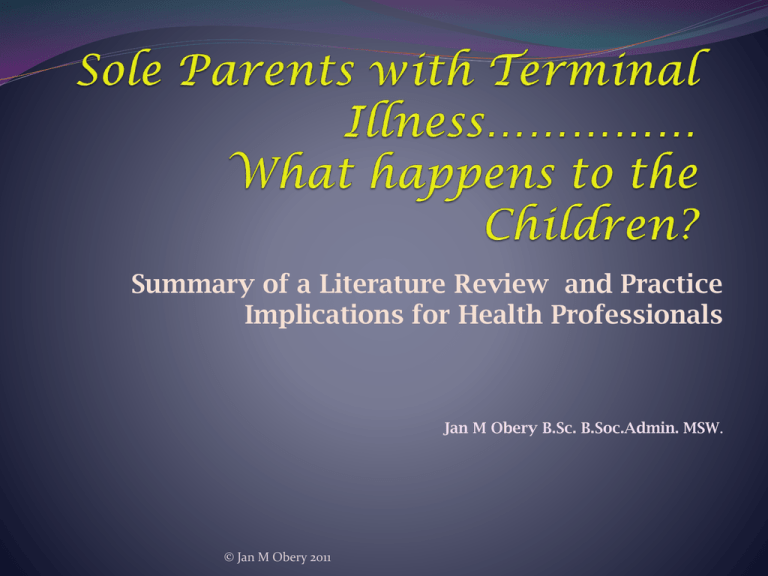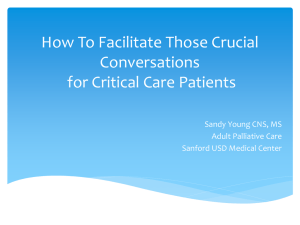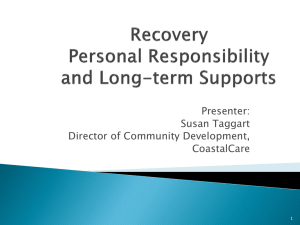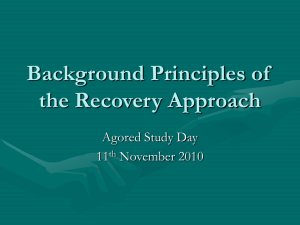Sole Parents with Terminal Illness***** What happens to the
advertisement

Summary of a Literature Review and Practice Implications for Health Professionals Jan M Obery B.Sc. B.Soc.Admin. MSW. © Jan M Obery 2011 Sole Parents with Terminal Illness ………………What Happens to the Children? Will Appointing a Guardian Statutory Declaration have all been utilised and can be used to represent the parents wishes but do not represent protection at law: i.e. can be challenged in Family Court. © Jan M Obery 2011 Sole Parents with Terminal Illness ………………What Happens to the Children? Decided to conduct a Literature Review The search terms used included : sole parent, single parent, dying father, dying mother, parent*death, death, dying, child orphaned, orphaned child, child custody, child* , custody plan, adolescence (where children only went up to 12 years of age), parenting plan, guardianship legal, and orphans. Medline, Embase, Cinahl, TRIP, Google Scholar, Proust, Academic ASAP, JStore, Web of Knowledge, Wiley Interscience and the Proquest Central databases. only 4 articles which related to terminal illness in general as it pertains to custody planning. © Jan M Obery 2011 Sole Parents with Terminal Illness ………………What Happens to the Children? Most articles related to HIV/Aids –decimation of carers in the 1980’s prompted responses which included the development of specialised programmes to address the many issues including legal issues and care of dependent children. The National Abandoned Infants Assistance Resource developed Standby Guardianship legislation as a response to the numbers of children “abandoned” as a result of the death of their (almost exclusively) mothers due to HIV/Aids © Jan M Obery 2011 Sole Parents with Terminal Illness ………………What Happens to the Children? Four main themes identified in the literature: 1. Lack of information both in regard to options and in regard to diagnosis /prognosis. 2. Factors contributing to “denial” of impending death. 3. Developing awareness of importance of addressing legal concerns as an aspect of endof-life-care. 4. Impact on the children. © Jan M Obery 2011 Sole Parents with Terminal Illness ………………What Happens to the Children? Barriers: 1. Information “The terminal illness of a parent presents the family with an experience far outside the expectable norm for the developmental stage of both child and family” Dunning 2006 pg 500. Cagle and Kovacs 2009 argue that the role of the social worker in providing education in end-of-life care is under-recognised and undervalued. The provision of concise, accurate information is essential in order to support and empower patients in negotiating the health care system. © Jan M Obery 2011 Jan M Obery 2012 Sole Parents with Terminal Illness ………………What Happens to the Children? Barriers: 1. Information The difficulty of prognostication Nadimi et al 2008 note that: Functional decline can occur rapidly. People often don’t realize this. Crucial for health professional to explain Dx; trxt options & prognosis at every stage of the illness. Onus on health professionals to have these discussions in order to allow time for legal issues to be dealt with. © Jan M Obery 2011 Jan M Obery 2012 Sole Parents with Terminal Illness ………………What Happens to the Children? Barriers: 1. Information Willis , Peck , Sells & Rodabaugh in a study of Custody Planning: A Retrospective Review of Oncology Patients Who Were Single Parents in 2001 Retrospective study families had suggestions for improvement focused need for more information Involving children more actively More written resources More counselling Requested frankness re: Prognosis. © Jan M Obery 2011 Sole Parents with Terminal Illness ………………What Happens to the Children? These information seeking behaviours are especially poignant given that the findings of this research indicated that: ‘Only five of the ten families developed custody plans that were ultimately successful. One-half of the families reported the patient had suffered with this issue and almost one-half of the children were not aware of the custody plans that had been arranged for them.’ In 40% of the cases, the children ultimately went to people to whom the deceased parents were opposed.’ Willis et al 2001 pg 380 (authors emphasis) © Jan M Obery 2011 Sole Parents with Terminal Illness ………………What Happens to the Children? Barriers 2. Denial “For parents who face terminal illness and eventual death, one of the most painful aspects of their disease is the realization of their inability to care for their children, plan their futures, and see them grow to maturity. For both patients and health care providers, there is often a degree of wishful thinking about custody options for the children involved.” Willis et al 2001 pg 381. © Jan M Obery 2011 Sole Parents with Terminal Illness ………………What Happens to the Children? Barriers 2. Denial Over 40% of the mothers currently had no custody arrangements for their children; most simply figured female relatives would care for their children should they no longer be able to. Perhaps the hesitancy to make plans is related to denial or avoidant coping among the mothers.’ Simoni study of mothers with HIV/Aids Pg 50. © Jan M Obery 2011 Jan M Obery 2012 Sole Parents with Terminal Illness ………………What Happens to the Children? 3.Legal Professionals –part of the TrXt team 3 key articles :Fleishman et al report on LegalHealth a programme set up to offer legal services to cancer pts and families. Rodabaugh et al focus on health care funding Zevon et al focus on impact of legal services support on pts perception of E-O-L care . © Jan M Obery 2011 Sole Parents with Terminal Illness ………………What Happens to the Children? 3.Legal Professionals –part of the TrXt team The development of the Cancer Council’s Legal and Financial service represents a significant resource in this area. Still an area of difficulty for those with nonmalignant Dx. The development of a service collaboration with Relationships Australia South Australia (RASA) . © Jan M Obery 2011 Sole Parents with Terminal Illness ………………What Happens to the Children? 4. Impact on Children “The powerful losses and changes experienced by a child during a family member’s disease process define the real meaning of ‘anticipatory grief’. It is not imagined post-death grief begun early, rather it is loss in the child’s here and now life and its accompanying grief”. Dunning 2006 pg 505. (Authors emphasis) © Jan M Obery 2011 Sole Parents with Terminal Illness ………………What Happens to the Children? “The combination of intervention directly with the child and guidance for the parents about how best to help their children offers the most effective help............Providing accurate information, in developmentally appropriate language is one of the most helpful things a clinician can offer. ” Dunning 2006 pg 511. © Jan M Obery 2011 Sole Parents with Terminal Illness ………………What Happens to the Children? Saldinger et al present a contradictory view to that expressed in most of the literature admonishing practitioners to “attend to the traumatic stress of ‘ordinary’ anticipated deaths rather than maintaining an exclusive grief orientation”. He describes the case study of a 14 year old daughter forced to visit her father in hospital even though her distress was so great that she developed migraines and threw up before each visit. 2003 pg 168 © Jan M Obery 2011 Sole Parents with Terminal Illness ………………What Happens to the Children? Evidenced throughout the literature covered by this review is an underlying respect for the patients and families and a strong desire on the part of health care and legal services practitioners to enhance the experience of end-of-life care, of preserving the sense of dignity and self-determination for patients. Clinical experience suggests that, at a time when patients often feel, correctly, that their lives, their life span and their bodies are out of their control the ability to negotiate a secure and appropriate custody plan for their children should facilitate some peace of mind. © Jan M Obery 2011 Sole Parents with Terminal Illness ………………What Happens to the Children? Since 2011 RASA has developed a collaborative approach to working with organisations delivering End-of-life-care services to mediate with the patient and other potential carers. This involved modifying the Family Dispute Resolution (FDR) model for this population of families. Jan M Obery 2012 Sole Parents with Terminal Illness ………………What Happens to the Children? Health professionals can also struggle with seeking to support the dying patient in obtaining the outcome that they want. Mediation, as in the FDR may not get the dying person exactly what they want but it does open up the conversation and can help to clarify what is really important in the dying parents mind in regard to future “directions for care” of the child/ren. © Jan M Obery 2011 Sole Parents with Terminal Illness ………………What Happens to the Children? Key Factors of the RASA modified Family Dispute Resolution service response include: A responsive service, i.e. usually within 48 hours. This is in recognition of the volatile nature of terminal illness, difficulty of prognostication and the potential for rapid deterioration. This service has been free to date. Jan M Obery 2012 Sole Parents with Terminal Illness ………………What Happens to the Children? Strong linkages and collaborations with other professionals working with the client, including legal advice and health professionals. It is critical to gain both a professional insight of the urgency of the situation and the clients understanding or acceptance of their prognosis in the first instance. Jan M Obery 2012 Sole Parents with Terminal Illness ………………What Happens to the Children? Clients wishes and fears for children are established over the initial course of the process. Most clients choose to exit the Family Dispute Resolution (FDR) process and leave the discussions to family members once they are reassured that their voice will be represented in the process. Clients then stay informed and consulted and sometimes re-join the process at a later stage. Jan M Obery 2012 Jan M Obery 2012 Sole Parents with Terminal Illness ………………What Happens to the Children? Whilst child focussed approach is standard in FDR, child consultation is more extensively offered and used in this process than in standard FDR. This can only occur after permission is sought from parent/s and child consultant is clear about the level of information that has been made available to the child. Jan M Obery 2012 Sole Parents with Terminal Illness ………………What Happens to the Children? Co-mediation model is essential as cases are lengthy, heavy on case work, need to be addressed urgently and have usually involved substantial family complexity and high levels of social disadvantage. Jan M Obery 2012 Sole Parents with Terminal Illness ………………What Happens to the Children? Forward directions for this service: Potential to develop a Statewide / national resource for parents facing a life threatening illness. Mediators intend to approach Family law pathways network to propose working group to do this. Need for a training model to be developed to increase capacity for other mediators to work in this sphere as there are minimal mediation articles or training options. Jan M Obery 2012 Sole Parents with Terminal Illness ………………What Happens to the Children? Practice Implications: • Engage the patient and family members and other potential support persons in conversation as early as possible after the referral . • The importance of providing information to the patient; relevant others and to the children with age appropriate material. • Focus on documenting the key values and beliefs the parent holds in regard to parenting rather than on who should provide the care. © Jan M Obery 2011 Jan M Obery 2012








